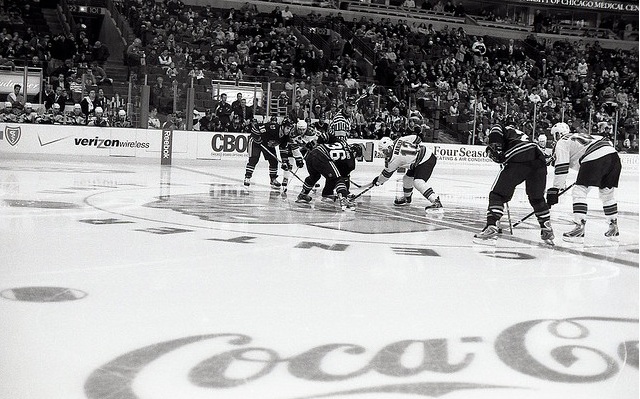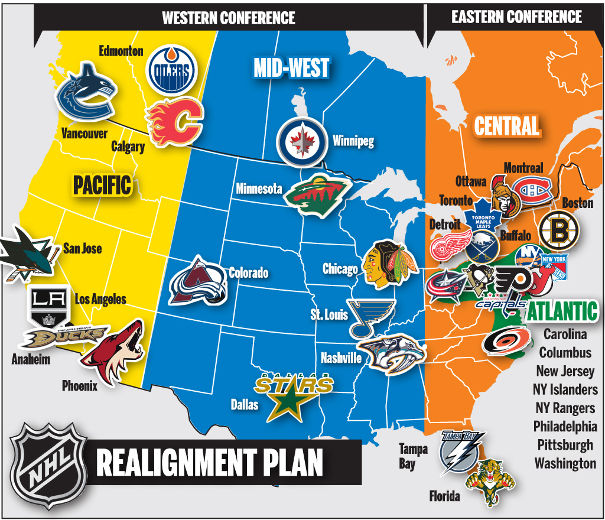NHL Realignment: The Good, The Bad And The Ugly
By Chuck Sudo in News on Mar 14, 2013 9:30PM

Under the new realignment plan, the "Original Six" match-ups of the Chicago Blackhawks and the Detroit Red Wings is cut down to two games a season. (Photo credit: Christopher Monaghan)
The National Hockey League Board of Governors approved a realignment plan Thursday that divides the league into two conferences and four evenly stocked divisions. The NHL Players Association granted its consent to the plan, meaning it will be in place for the 2013-14 season.
The two divisions will be geographically situated, with the Eastern Conference consisting of 16 teams and the Western Conference 14. The realignment plan solves some long-standing issues voiced by owners and players, but not all fans will be happy with, say, seeing the Original Six rivalry between the Chicago Blackhawks and Detroit Red Wings — one that dates back to the league’s formation — reduced to two games per season.
But the league has survived previous realignments (not to mention expansions and lockouts) and this could be a boon to the league. But there are still some kinks in the plan. Let’s take a look at the benefits, disadvantages and “WTF?” aspects of the realignment plan.
The Good
Less Travel, More Convenient Start Times: Since the four new divisions are based on geographic location, teams will be able to save money on travel expenses and the league can better schedule marquee teams during prime time slots. The realignment plan moves Detroit and Columbus to the Eastern Conference, while Winnipeg, which relocated from Atlanta, returns to the Western Conference. Colorado moves into a division with the Blackhawks, Dallas, Winnipeg, St. Louis, Minnesota and Nashville.

Illustration via Edmonton Sun
Every Team Visits Every Opposing Arena: This will make fans of Original Six match-ups happy. If you’re a Rangers fan, for example, you’re guaranteed to see Boston, Chicago, Detroit, Montreal and Toronto at Madison Square Garden each season, as well as Western Conference powers like Anaheim, Vancouver and Los Angeles.
Developing Natural Regional Rivalries: The new divisional alignments will allow for the growth of new rivalries based on location, such as Colorado and Chicago in the Western Conference’s “Division B” and four of the six Original Six franchises (Boston, Detroit, Montreal and Toronto) in Eastern Conference Division C. Here’s what Chicago Blackhawks historian Bob Verdi had to say about natural rivalries with previous realignments:
In 1970-71, when the NHL expanded from 12 to 14 teams, the Blackhawks left all five ancient foes behind midst much wringing of hands and transferred to the West, and nobody died. In fact, the dramatic facelift precipitated different grudges. Before too long, (Chicago) Stadium fans learned to boo the St. Louis Blues and Minnesota North Stars.“Chicago was a natural rival for us,” recalled Scotty Bowman, the Blackhawks’ Hall of Fame Senior Advisor who coached the Blues when the NHL grew to 12 teams in 1967. “There was the geographic factor, both cities being close to each other. Plus the rivalry in other sports, like Cubs and Cardinals, carried over to hockey. Also, we drafted Glenn Hall from the Blackhawks, and he put hockey on the map in St. Louis. Chicago was always the biggest draw in our building, and over time the two teams have developed quite a thing between them.
The Bad
The Divisions are Still Imperfect: The Eastern Conference’s Division D consists of Carolina, Columbus, New Jersey, the New York Islanders and Rangers, Philadelphia, Pittsburgh and Washington. Division C has Boston, Detroit, Montreal, Toronto, Buffalo, Florida, Tampa Bay and Ottawa. If the NHL wanted to make an “Eastern Seaboard” division they could have lumped Boston, the three New York/New Jersey teams, Washington, Philadelphia and the a combination of the two Florida teams and Carolina. As it stands, the Lightning and Panthers will have to fly over Division D territory to take on their rivals in Division C.
West Coast Teams Will Need To Work Harder To Fill Arenas: Detroit’s shift to the Eastern Conference leaves the Blackhawks and Canucks as the marquee teams in the Western Conference. Chicago brought some much-needed attention to the league post-lockout with its record-setting points streak to start the season, while Vancouver is the team everyone loves to hate. With the glamour teams in the East only visiting West Coast arenas once a season, it will be interesting to see if the Kings, Ducks, Sharks and Coyotes can finally develop natural rivalries along the California coast (and Arizona desert).
Expansion is All But Guaranteed: With 14 teams in the Western Conference the realignment plan all but cries for two teams to be added to the league so the conferences will have an equal complement of teams because the other option — contracting a couple of underperforming franchises — isn’t going to happen. One of the major reasons the NHL suffered two lockouts in a decade was its rapid and short-sighted expansion into markets with no knowledge of the game.
Bloomberg View’s Jonathan Mahler, in his epic takedown of NHL Commissioner Gary Bettman last December, half-jokingly suggested the league pare down to the Original Six and a few cities with rabid hockey fan bases like Pittsburgh, Philly and Vancouver. We’d be down with that, personally. No snow on the ground; no hockey.
The Ugly
The Stanley Cup Playoffs Became More Complicated: The playoffs will still consist of eight teams in each conference, but they’ll be division-based, with a wild-card team from each division. Let’s let the league explain, because our heads hurt right now:
The top three teams in each division will make-up the first 12 teams in the playoffs. The remaining four spots will be filled by the next two highest-placed finishers in each conference, based on regular-season points and regardless of division. It will be possible, then, for one division to send five teams to the postseason while the other sends three.The seeding of the wild-card teams within each divisional playoff will be determined on the basis of regular-season points. The division winner with the most points in the conference will be matched against the wild-card team with the lowest number of points; the division winner with the second-most points in the conference will play the wild-card team with the second fewest points.
The teams finishing second and third in each division will play in the first round of the playoffs. The winners of each series will play for berths in the Conference Championship series.
We had to read that twice because we thought we read “the party in the first part shall be known in this contract as the party in the first part.” Digressing, this has both good and bad connotations. It is conceivable to see five teams from a division make the playoffs but, as Nashville Predators GM David Polie told NHL.com, “if we made it as the wild card and, say, were the fifth-place team in our division and, say, Vancouver was the first-place team, you're going to Vancouver for the first round -- which is also not fair for Vancouver, who is the overall best team.
"You can't cover off for every situation."